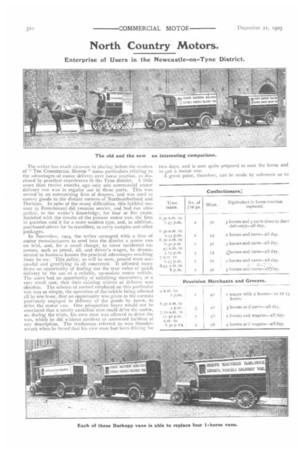North Country Motors.
Page 12

Page 13

If you've noticed an error in this article please click here to report it so we can fix it.
Enterprise of Users in the Newcastle-on-Tyne District.
The writer has much pleasure in placing before the readers of " THE COMMERCIAL MOTOR " some particulars relating to the advantages of motor delivery over horse traction, as disclosed by practical experiences in the Tyne district. A little more than twelve months ago only one commercial motor delivery van was in regular use in these parts. This was owned by an enterprising firm of drapers, and was used to convey goods to the distant corners of Northumberland and Durham. In spite of the many difficulties, this faithful servant (a Frenchman) did yeoman service, and had run altogether, to the writer's knowledge, for four or five years. Satisfied with the results of the pioneer motor van, the firm in question sold it for a more modern type, and, in addition, purchased others for its travellers, to carry samples and other packages.
In November, 1904, the writer arranged with a lirm of motor manufacturers to send into the district a motor van on trial, and, for a small charge, to cover incidental expenses, such as petrol, oil, and driver's wages, he demonstrated to business houses the practical advantages resulting from its use. This policy, as will be seen, proved most successful and gratifying to all concerned. It afforded many firms an opportunity of finding out the true value of quick delivery by the use of a reliable, up-to-date motor vehicle. The users had an opportunity of satisfying themselves, at a very small cost, that their existing system of delivery was obsolete. The scheme of control employed on this particular van was so simple, the operation of the vehicle being effected all by one lever, that an opportunity was given to the carman previously engaged in delivery of the goods by horse, to drive the motor van. One prospective buyer would not be convinced that a totally unskilled man could drive the motor, so, during the trials, his own man was allowed to drive the van, which he did without accident or untoward incident of any description. The tradesman. referred to was thunderstruck when he heard that his own man had been driving for
two days, and is now quite prepared to oust the horse and to get a motor van. A greal point, therefore, can be made by salesmen as to the simplicity of control, when existing cart and wagon men may safely be transferred from horse to motor haulage, as was established by the above-mentioned incident.
During the trials referred to the distances run by the motor van were carefully tabulated, and particulars of the work previously dealt with by horse delivery obtained from the tradesmen. Some of the actual results are given above. It will be noticed that, in a z-hour day, the motor van did. 96 miles, which would have taken a two-horse wagon two long days of 14 or 15 hours each. The horses would then require to have one day's rest before repeating the journey, which the motor would not require, The table of statistics of the trials, given on page 310, will he interesting.
The practical tests recorded above resulted in a large number of orders being placed, and one firm alone, since the above trial, has placed orders for five petrol commercial motorcars and lorries to carry from 12CWt. of travellers' samples to two tons of goods.
Some incidents worth mentioning were the outcome of these trials. The surprise and astonishtnent of the firms at the rapidity with which their goods were delivered was informing, and the warehouse man at one stores imagined the van to possess uncanny properties, when it completed its first round in about one-third of the time usually taken by the horse van. Everybody now agrees that the movement is making rapid strides. With regard to the sizes of motor vans in this district, most of these carry from 15cwt. up to two tons, and I regret that at present—with the exception of a newspaper office—the small 5cwt. to tocwt.van has not made any headway at all. The smaller tradesman, like the man of moderate means and his car, will hesitate to pay 2(3‘) to 4,25o when he can
buy a pony and cart for 440 to or less, and for short distances, with frequent stoppages, there is some cause for his wisdom, as prices rule at the moment. My own personal opinion is that the tri-car arrangement, with front box-carrier, should be brought more before this class of trades_ man, and I hope soon to be able to arrange to carry out such trials on the lines of the van trials. One of our leading railway companies in the North is making great progress with motor delivery, and the results so far are
very encouraging. In August one of these vans, which is capable of carrying 3ocwt., delivered in one week 424 parcels and packages, and collected 261, making a total of 685, the total weight handled being over 19 tons. The number of journeys made was is, time taken 46 hours, and the mileage 177. This work by motor represents the work of four horses, if compared upon the weight and mileage basis, and of five horses if taken upon the weight and time it would represent.
I understand it is the practice of most large railway companies to work their horses one full day, to rest them the morning of the second day, to work them the afternoon and following morning, and to rest them that afternoon, and so on, whereas the motor van can be worked any 11Oliiber of hours without this consideration, FRANK LITTLE, A.M.1.E.F..


















